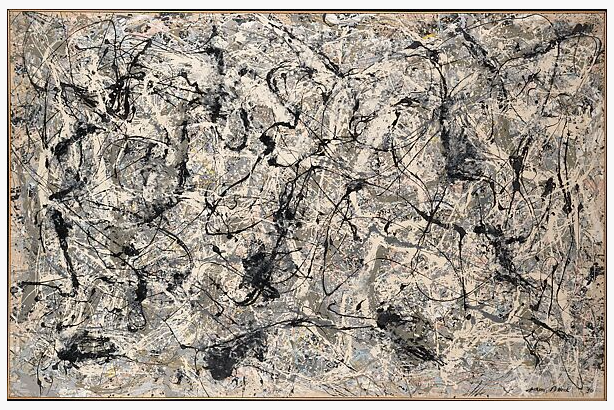Abstract expressionism is an art aesthetic that often exhibits traits such as non-uniformity, asymmetry, and randomness. It is known for its emphasis on spontaneous, automatic, or subconscious creation, and it marked a shift from representational art to non-representational forms. The movement is characterized by a focus on the act of painting itself, exploring the physical properties of paint and the process of applying it to the canvas.
Abstract expressionism in the United States emerged as a distinct art movement in the immediate aftermath of World War II and gained mainstream acceptance in the 1950s. [1] It was primarily based in New York and involved famous artists such as Jackson Pollock (1912–1956), Willem de Kooning (1904–1997), Franz Kline (1910–1962), Lee Krasner (1908–1984), Robert Motherwell (1915–1991), William Baziotes (1912–1963), Mark Rothko (1903–1970), Barnett Newman (1905–1970), Adolph Gottlieb (1903–1974), Richard Pousette-Dart (1916–1992), and Clyfford Still (1904–1980). [2]

Number 28, 1950 by Jackson Pollock 1950
One of the most famous artists associated with Abstract Expressionism is Jackson Pollock. Pollock is known for his drip paintings, in which he would pour, drip, and splatter paint onto a canvas laid on the ground. This technique allowed him to create dynamic, non-uniform compositions that were filled with energy and movement. Pollock’s work exemplifies the Abstract Expressionist belief in the importance of the artist’s gesture and the physical act of painting. In the picture above, you can see this highlighted in Pollock’s Number 28. [3]

Mark Rothko Orange and Tan, 1954
Another key figure in the movement is Mark Rothko, who is known for his large, color-field paintings. Rothko’s works feature soft, blurred rectangles of color that seem to float on the canvas. His paintings are often seen as meditative and introspective, inviting viewers to experience deep emotional responses. In the image above, you can see 2 rectangles which embody Rothko’s famous format. [4]

Boon by James Brooks, 1957 [1]
In this picture by James Brookes, you can see the blotches of color that are somewhat, but not quite random.
Overall, Abstract Expressionism represents a pivotal moment in the history of art, when artists moved away from depicting the external world and instead focused on conveying their internal experiences and emotions through abstract forms.
Chat GPT was used to assist in writing this post.
- https://en.wikipedia.org/wiki/Abstract_expressionism
- https://www.metmuseum.org/toah/hd/abex/hd_abex.htm
- https://www.theartstory.org/movement/abstract-expressionism/
- https://www.nga.gov/features/mark-rothko.html


3 Comments. Leave new
Hey Kyle, your explanation of abstract expressionism was done really well and I like the examples you added of different works to help explain your writing better. I would have loved to read more about how its opposite from your current aesthetic project though.
Hi Kyle, I enjoyed reading your post on abstract expressionism. I like how you included the influential artists that helped shaped the aesthetic, and your picture examples are very interesting. It’s interesting that in these art pieces the process of physically putting the paint on the canvas is included in the idea of the piece. What is your project’s aesthetic that this aesthetic is the opposite of?
Hi Kyle, I think you did a great job explaining Abstract Expressionism and its history. I like the example pieces you used to visually represent this aesthetic. I would like to know which aesthetic are you following in your project. I think it would be interesting to note what your project’s aesthetic is to compare and contrast it with this one.